Swimming crabs (phylum Arthropoda, subphylum Crustacea, class Malacostraca, order Decapoda, suborder Pleocyemata, infraorder Brachyura, superfamily Portunoidea, family Portunidae) are so-named as the last pair of legs are paddle-like, making them good swimmers.
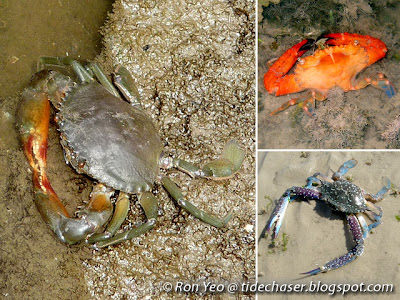
The carapaces of most swimming crabs are somewhat hexagonal, and the margin of the front half is often lined with sharp teeth. The various species live in a variety of habitats, from soft substrates like mudflats and sandflats to harder bottoms like coral reefs and rubble. The diet varies between the species as well, ranging from slow-moving prey such as snails and annelids to fast-moving ones such as fish and shrimps.
Like other true crabs, swimming crabs have a broad carapace, and a very short and flattened abdomen which is usually folded underneath the body. They also have five pairs of "legs" (including the clawed arms, or chelipeds), and hence they are placed in the order Decapoda ("deca" means "ten", while "poda" means "feet"). The gills are leaf-like - a distinctive characteristic of decapods from the suborder Pleocyemata. And as with other crustaceans from the class Malacostraca, their body comprises three main parts - a head with five segments, a thorax with eight segments, and an abdomen with six segments. The head is fused to the thorax, forming a cephalothorax. They have a tough exoskeleton strengthened with calcium carbonate, and the carapace covers the gills but not the abdomen.

Swimming crabs reproduce sexually, and have separate sexes. They mate face-to-face, usually with the male on top and the female below. The females can usually be distinguished from the males by having a broader abdomen. This is an adaptation to allow them to carry the eggs under their abdomen until they hatch. During the breeding season, the male can often be seen holding onto a female from the back, guarding her from other competing suitors. The female will soon moult, and the male will then mate with her.

Swimming crabs are sometimes confused with moon crabs (family Matutidae) due to the paddle-like back legs, but unlike swimming crabs, all the legs of moon crabs are paddle-like. The first three pairs of legs of swimming crabs are also relatively flat, which make many of them good burrowers as well.
Many swimming crabs are commercially important species, and in fact, most of the crabs available in local restaurants and markets, such as flower crabs and mud crabs, are swimming crabs. Here are some of the swimming crabs that can be seen Singapore.

The Orange Mud Crab (Scylla olivacea) can be recognised by its bright orange chelipeds (the clawed arms). It is usually found in the mangrove forest, and are sometimes seen hiding among the roots of the trees. It is commonly trapped and consumed in the region. They feed on a variety of small animals, including other shelled invertebrates, which they will crush with their powerful pincers. The maximum carapace width is about 18cm.
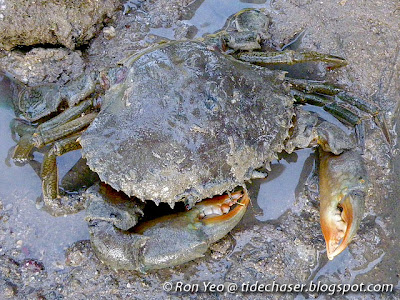
The Green Mud Crab (Scylla paramamosain) is sometimes confused with the previous species, though the chelipeds are mostly dull green and only some parts are of a dull orange. This species is mostly found on sandier areas near mangrove, and sometimes even in seagrass meadows with muddy substrates. Like the previous species, it is commonly trapped and consumed in the region. They feed on a variety of small animals, including other shelled invertebrates, which they will crush with their powerful pincers. The maximum carapace width is about 15cm.

The Purple Mud Crab (Scylla tranquebarica) has distinctive purplish claws. I have seen it in the mangrove, and also sandy areas near seagrass meadows (where a mating pair were spotted). This huge crab is commonly trapped and consumed in the region. They feed on a variety of small animals, including other shelled invertebrates, which they will crush with their powerful pincers. The maximum carapace width is about 20cm.
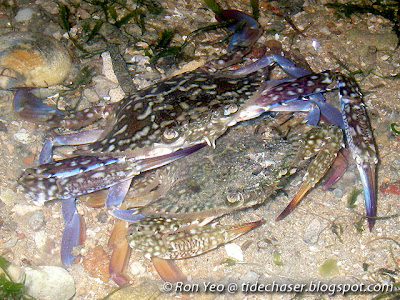
The Flower Crab (Portunus pelagicus) is often found in shallow waters, either in seagrass meadows or near mangroves and coral reefs. They usually hide under the soft substrates in the day, and emerge to feed at dusk. Despite being very agile swimmers, these crabs do not move well out of water. While they are extensively caught for food, they do not live for long out of water and decompose quickly. The males are bluish with a brownish-grey carapace marked with pale spots and blotches, while the females are all brownish and marked with the same pale patterns. The front of the carapace has four acutely triangular teeth between the eyes. The chelipeds are armed with many sharp spines, which help to wound the crab's prey (mostly small fishes). The above photo features a male guarding a female, waiting for her to moult so that he can mate with her. The carapace of this species can reach a width of about 20cm.

The Crenate Swimming Crab (Thalamita crenata) can be recongnised by its olive to dark green coloration and pale blue pincers. It is sometimes confused with the previous species, but can be distinguished by the lack of the blotchy pale patterns on the carapace of the latter. In addition, the front of the carapace has six equal-sized, rounded lobes between the eyes, and on each side of the carapace are five teeth. This species prefers areas near mangroves or with muddy-rocky substrates, and are commonly caught for consumption. It is generally smaller than most other commercial swimming species, with the carapace reaching a maximum width of about 8cm, and hence has a much lower market value.

The Blue Swimming Crab (Thalamita danae) is easily recognised by the dark blue coloration and the lack of obvious granules on the claws. It has been seen on rocky shores and among coral rubble. This small crab is sometimes collected for consumption, but has little market value due to the small size - the maximum carapace width is about 7cm. Like other species of the genus Thalamita, it has five teeth on each of the front-left and front-right sides of the carapace.
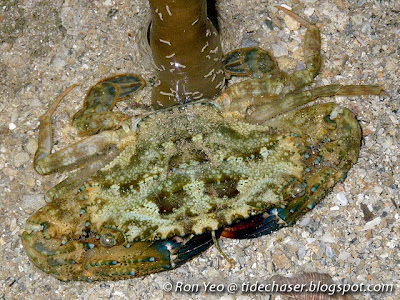
The Prymna Swimming Crab (Thalamita prymna) is mostly of a yellowish brown, greenish brown or bluish brown coloration with blue spines and granules. It is sometimes confused with the previous species, but the latter lacks the numerous granules marking the claws. It is very similar to the next species as well, and is in fact considered to be of the same species previously. The gaps between the teeth at the front of the carapace are shallower though, and the teeth are usually blunt. Like other species of the genus Thalamita, it has five teeth on each of the front-left and front-right sides of the carapace. This species is commonly found on rocky shores. The maximum width of its carapace is about 7cm. This small species is sometimes eaten by the locals.

The Orange Swimming Crab (Thalamita pelsarti) is usually orange with bluish spines and granules. It can appear quite similar to the previous species, but is more densely covered in granules. Also, there is a deep and open notch between the teeth by the eye and the last frontal lobe. In addition, the joints of the legs are often orange or reddish. Like other species of the genus Thalamita, it has five teeth on each of the front-left and front-right sides of the carapace. The carapace gets to a maximum width of about 6cm. This small crab is occasionally consumed by locals.
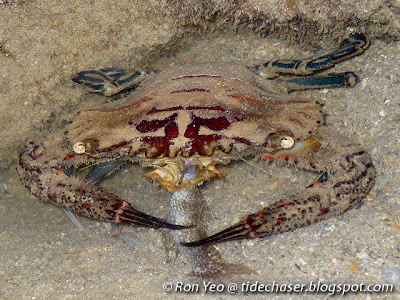
The Red Swimming Crab (Thalamita spinimana) can usually be recognised by the reddish coloration, but there are variations and some specimens may be bright orange instead. The chelipeds are covered in spines and granules of the same colour as the chelipeds, unlike the previous species which has bluish spines and granules. Like other species of the genus Thalamita, it has five teeth on each of the front-left and front-right sides of the carapace. The front of the carapace bear six blunt lobes, and the second lobe and fifth lobes (from left to right) appear truncated and elongated.

The above features a reddish-orange specimen of the Red Swimming Crab. Generally, this species is commonly seen on rocky shores, coral reefs and coral rubble flats. The maximum carapace width is about 9cm. It is seldom seen in the market due to its small size, but is sometimes collected by locals for consumption.

The Crucifix Crab (Charybdis feriatus) has a characteristic yellowish cross on the back of its carapace, which gives it its common name. The legs are banded or with dark blotches, usually marked with pale spots. Interestingly, young specimens have been observed on the bell of large jellyfish in Singapore waters, but the exact relationship is not known. It can be found on sandy to muddy subtidal areas. This species is an important commercial species in the more northern waters, but is not abundant enough in Southeast Asia to be of high commercial value. The carapace can grow to about 12cm wide, with six teeth on each side on the front half.

The Banded-legged Swimming Crab (Charybdis annulata) has distinctive broad dark blue to brown bands on the legs. The colour appears to be quite variable, with records of bluish, orange and brown specimens. This species is usually found near rocky areas and coral reefs. This species is sometimes collected for consumption. The maximum carapace width is about 7cm.

The Ridged Swimming Crab (Charybdis natator) has a light brown carapace, reddish claws and undersides with electric blue markings. The eyes are reddish with white specks. This species is usually found among sand, rocks and pebbles in subtidal areas. The maximum carapace can reach about 17cm wide, and hence this species has some commercial value due to the relatively large size.

The Spiny Hands (Charybdis hellerii) is a common swimming crab in the region. The bigger individuals have an orange to creamed coloured carapace and purple legs, while smaller ones may have reddish patches on the carapace. The frontal teeth are acutely triangular, with v-shaped notches between each tooth, and on each side of the carapace are six teeth on the front half. The fingers of the pincers are dark reddish brown in colour. This crab is usually found under rocks and stones or among corals. The carapace gets to about 8cm wide, and it is sometimes collected by locals for consumption.

Tiny swimming crabs like the above are often seen on our shores, which could be juveniles. I am not sure which species they belong to though.
References

The carapaces of most swimming crabs are somewhat hexagonal, and the margin of the front half is often lined with sharp teeth. The various species live in a variety of habitats, from soft substrates like mudflats and sandflats to harder bottoms like coral reefs and rubble. The diet varies between the species as well, ranging from slow-moving prey such as snails and annelids to fast-moving ones such as fish and shrimps.
Like other true crabs, swimming crabs have a broad carapace, and a very short and flattened abdomen which is usually folded underneath the body. They also have five pairs of "legs" (including the clawed arms, or chelipeds), and hence they are placed in the order Decapoda ("deca" means "ten", while "poda" means "feet"). The gills are leaf-like - a distinctive characteristic of decapods from the suborder Pleocyemata. And as with other crustaceans from the class Malacostraca, their body comprises three main parts - a head with five segments, a thorax with eight segments, and an abdomen with six segments. The head is fused to the thorax, forming a cephalothorax. They have a tough exoskeleton strengthened with calcium carbonate, and the carapace covers the gills but not the abdomen.

Swimming crabs reproduce sexually, and have separate sexes. They mate face-to-face, usually with the male on top and the female below. The females can usually be distinguished from the males by having a broader abdomen. This is an adaptation to allow them to carry the eggs under their abdomen until they hatch. During the breeding season, the male can often be seen holding onto a female from the back, guarding her from other competing suitors. The female will soon moult, and the male will then mate with her.

Swimming crabs are sometimes confused with moon crabs (family Matutidae) due to the paddle-like back legs, but unlike swimming crabs, all the legs of moon crabs are paddle-like. The first three pairs of legs of swimming crabs are also relatively flat, which make many of them good burrowers as well.
Many swimming crabs are commercially important species, and in fact, most of the crabs available in local restaurants and markets, such as flower crabs and mud crabs, are swimming crabs. Here are some of the swimming crabs that can be seen Singapore.

The Orange Mud Crab (Scylla olivacea) can be recognised by its bright orange chelipeds (the clawed arms). It is usually found in the mangrove forest, and are sometimes seen hiding among the roots of the trees. It is commonly trapped and consumed in the region. They feed on a variety of small animals, including other shelled invertebrates, which they will crush with their powerful pincers. The maximum carapace width is about 18cm.

The Green Mud Crab (Scylla paramamosain) is sometimes confused with the previous species, though the chelipeds are mostly dull green and only some parts are of a dull orange. This species is mostly found on sandier areas near mangrove, and sometimes even in seagrass meadows with muddy substrates. Like the previous species, it is commonly trapped and consumed in the region. They feed on a variety of small animals, including other shelled invertebrates, which they will crush with their powerful pincers. The maximum carapace width is about 15cm.

The Purple Mud Crab (Scylla tranquebarica) has distinctive purplish claws. I have seen it in the mangrove, and also sandy areas near seagrass meadows (where a mating pair were spotted). This huge crab is commonly trapped and consumed in the region. They feed on a variety of small animals, including other shelled invertebrates, which they will crush with their powerful pincers. The maximum carapace width is about 20cm.

The Flower Crab (Portunus pelagicus) is often found in shallow waters, either in seagrass meadows or near mangroves and coral reefs. They usually hide under the soft substrates in the day, and emerge to feed at dusk. Despite being very agile swimmers, these crabs do not move well out of water. While they are extensively caught for food, they do not live for long out of water and decompose quickly. The males are bluish with a brownish-grey carapace marked with pale spots and blotches, while the females are all brownish and marked with the same pale patterns. The front of the carapace has four acutely triangular teeth between the eyes. The chelipeds are armed with many sharp spines, which help to wound the crab's prey (mostly small fishes). The above photo features a male guarding a female, waiting for her to moult so that he can mate with her. The carapace of this species can reach a width of about 20cm.

The Crenate Swimming Crab (Thalamita crenata) can be recongnised by its olive to dark green coloration and pale blue pincers. It is sometimes confused with the previous species, but can be distinguished by the lack of the blotchy pale patterns on the carapace of the latter. In addition, the front of the carapace has six equal-sized, rounded lobes between the eyes, and on each side of the carapace are five teeth. This species prefers areas near mangroves or with muddy-rocky substrates, and are commonly caught for consumption. It is generally smaller than most other commercial swimming species, with the carapace reaching a maximum width of about 8cm, and hence has a much lower market value.

The Blue Swimming Crab (Thalamita danae) is easily recognised by the dark blue coloration and the lack of obvious granules on the claws. It has been seen on rocky shores and among coral rubble. This small crab is sometimes collected for consumption, but has little market value due to the small size - the maximum carapace width is about 7cm. Like other species of the genus Thalamita, it has five teeth on each of the front-left and front-right sides of the carapace.

The Prymna Swimming Crab (Thalamita prymna) is mostly of a yellowish brown, greenish brown or bluish brown coloration with blue spines and granules. It is sometimes confused with the previous species, but the latter lacks the numerous granules marking the claws. It is very similar to the next species as well, and is in fact considered to be of the same species previously. The gaps between the teeth at the front of the carapace are shallower though, and the teeth are usually blunt. Like other species of the genus Thalamita, it has five teeth on each of the front-left and front-right sides of the carapace. This species is commonly found on rocky shores. The maximum width of its carapace is about 7cm. This small species is sometimes eaten by the locals.

The Orange Swimming Crab (Thalamita pelsarti) is usually orange with bluish spines and granules. It can appear quite similar to the previous species, but is more densely covered in granules. Also, there is a deep and open notch between the teeth by the eye and the last frontal lobe. In addition, the joints of the legs are often orange or reddish. Like other species of the genus Thalamita, it has five teeth on each of the front-left and front-right sides of the carapace. The carapace gets to a maximum width of about 6cm. This small crab is occasionally consumed by locals.

The Red Swimming Crab (Thalamita spinimana) can usually be recognised by the reddish coloration, but there are variations and some specimens may be bright orange instead. The chelipeds are covered in spines and granules of the same colour as the chelipeds, unlike the previous species which has bluish spines and granules. Like other species of the genus Thalamita, it has five teeth on each of the front-left and front-right sides of the carapace. The front of the carapace bear six blunt lobes, and the second lobe and fifth lobes (from left to right) appear truncated and elongated.

The above features a reddish-orange specimen of the Red Swimming Crab. Generally, this species is commonly seen on rocky shores, coral reefs and coral rubble flats. The maximum carapace width is about 9cm. It is seldom seen in the market due to its small size, but is sometimes collected by locals for consumption.

The Crucifix Crab (Charybdis feriatus) has a characteristic yellowish cross on the back of its carapace, which gives it its common name. The legs are banded or with dark blotches, usually marked with pale spots. Interestingly, young specimens have been observed on the bell of large jellyfish in Singapore waters, but the exact relationship is not known. It can be found on sandy to muddy subtidal areas. This species is an important commercial species in the more northern waters, but is not abundant enough in Southeast Asia to be of high commercial value. The carapace can grow to about 12cm wide, with six teeth on each side on the front half.

The Banded-legged Swimming Crab (Charybdis annulata) has distinctive broad dark blue to brown bands on the legs. The colour appears to be quite variable, with records of bluish, orange and brown specimens. This species is usually found near rocky areas and coral reefs. This species is sometimes collected for consumption. The maximum carapace width is about 7cm.

The Ridged Swimming Crab (Charybdis natator) has a light brown carapace, reddish claws and undersides with electric blue markings. The eyes are reddish with white specks. This species is usually found among sand, rocks and pebbles in subtidal areas. The maximum carapace can reach about 17cm wide, and hence this species has some commercial value due to the relatively large size.

The Spiny Hands (Charybdis hellerii) is a common swimming crab in the region. The bigger individuals have an orange to creamed coloured carapace and purple legs, while smaller ones may have reddish patches on the carapace. The frontal teeth are acutely triangular, with v-shaped notches between each tooth, and on each side of the carapace are six teeth on the front half. The fingers of the pincers are dark reddish brown in colour. This crab is usually found under rocks and stones or among corals. The carapace gets to about 8cm wide, and it is sometimes collected by locals for consumption.

Tiny swimming crabs like the above are often seen on our shores, which could be juveniles. I am not sure which species they belong to though.
References
- Carpenter, K. E. & V. H. Niem (eds), 1998-2001. FAO species identification guide for fishery purposes. The living marine resources of the Western Central Pacific. Volumes 1 to 6. FAO, Rome. pp. 1-4218.
- De Grave, S., N. D. Pentcheff , S. T. Ahyong, T.-Y. Chan, K. A. Crandall, P. C. Dworschak, D. L. Felder, R. M. Feldmann, C. H. J. M. Fransen, L. Y. D. Goulding, R. Lemaitre, M. E. Y. Low, J. W. Martin, P. K. L. Ng, C. E. Schweitzer, S. H. Tan, D. Tshudy & R. Wetzer. 2009. A classification of living and fossil genera of decapod crustaceans. The Raffles Bulletin of Zoology, supplement 21, pp. 1-109.
- Debelius, H. 1999. Crustacea - Guide of the world. IKAN, Frankfurt. 321pp.
- ETI BioInformatics. 2012. Marine species identification portal. Retrieved Jul 8, 2013, from http://species-identification.org.
- Ng, P. K. L., S. S. L. Lim, L. K. Wang & L. W. H. Tan. 2007. Private lives: An exposé of Singapore's shores. The Raffles Museum of Biodiversity Research, Department of Biological Sciences, National University of Singapore. 212 pp.
- Ng, P. K .L., R. T. Corlett & H.T.W. Tan (eds.). 2011. Singapore biodiversity: An encyclopedia of the natural environment and sustainable development. Singapore: Editions Didier Millet. 552 pp.
- Trivedi, J. N. & K. D. Vachhrajani. 2012. New record of color morphs of brachyuran crab Charybdis annulata Fabricius, 1798 (Decapoda: Portunidae). Arthropods, 2012, 1(4):129-135.
- Wee, D. P. C. & P. K. L. Ng. 1995. Swimming crabs of the genera Charybdis de Haan, 1833, and Thalamita Latrielle, 1829 (Crustacea: Decapoda: Brachyura: Portunidae) from peninsular Malaysia and Singapore. Raffles Bulletin of Zoology 1: 1-128.
- World Register of Marine Species. 2012. Retrieved Jun 10, 2013, from http://www.marinespecies.org.

No comments:
Post a Comment